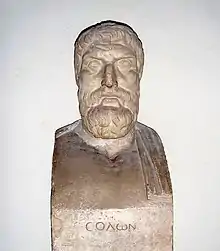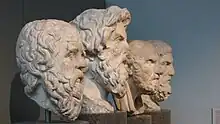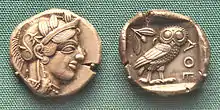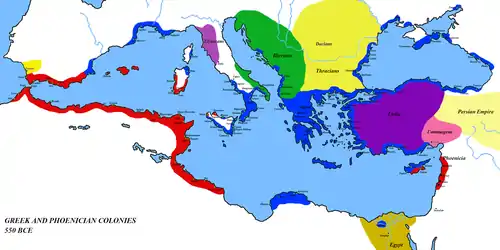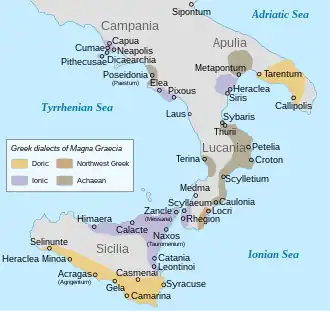The Ancient Greece Portal
Ancient Greece (Greek: Ἑλλάς, romanized: Hellás) was a northeastern Mediterranean civilization, existing from the Greek Dark Ages of the 12th–9th centuries BC to the end of classical antiquity (c. 600 AD), that comprised a loose collection of culturally and linguistically related city-states and other territories. Most of these regions were officially unified only once, for 13 years, under Alexander the Great's empire from 336 to 323 BC. In Western history, the era of classical antiquity was immediately followed by the Early Middle Ages and the Byzantine period.
Three centuries after the Late Bronze Age collapse of Mycenaean Greece, Greek urban poleis began to form in the 8th century BC, ushering in the Archaic period and the colonization of the Mediterranean Basin. This was followed by the age of Classical Greece, from the Greco-Persian Wars to the 5th to 4th centuries BC, and which included the Golden Age of Athens. The conquests of Alexander the Great spread Hellenistic civilization from the western Mediterranean to Central Asia. The Hellenistic period ended with the conquest of the eastern Mediterranean world by the Roman Republic, and the annexation of the Roman province of Macedonia in Roman Greece, and later the province of Achaea during the Roman Empire.
Classical Greek culture, especially philosophy, had a powerful influence on ancient Rome, which carried a version of it throughout the Mediterranean and much of Europe. For this reason, Classical Greece is generally considered the cradle of Western civilization, the seminal culture from which the modern West derives many of its founding archetypes and ideas in politics, philosophy, science, and art. (Full article...)
Selected article -
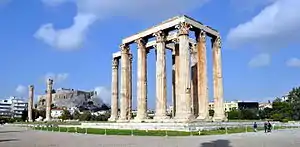
This list of ancient Greek temples covers temples built by the Hellenic people from the 6th century BC until the 2nd century AD on mainland Greece and in Hellenic towns in the Aegean Islands, Asia Minor, Sicily and Italy ("Magna Graecia"), wherever there were Greek colonies, and the establishment of Greek culture. Ancient Greek architecture was of very regular form, the construction being post and lintel.
There are three clearly defined styles: the Doric order, found throughout Greece, Sicily and Italy; the Ionic order, from Asia Minor, with examples in Greece; and the more ornate Corinthian order, used initially only for interiors, becoming more widely used during the Hellenistic period from the 1st century BC onwards and used extensively by Roman architects. (Full article...)Selected location -
.jpg.webp)
The Temple of Artemis is an Archaic Greek temple in Corfu, Greece, built in around 580 BC in the ancient city of Korkyra (or Corcyra), now called Corfu. It is found on the property of the Saint Theodore monastery, which is located in the suburb of Garitsa. The temple was dedicated to Artemis. It is known as the first Doric temple exclusively built with stone. It is also considered the first building to have incorporated all of the elements of the Doric architectural style. Very few Greek temple reliefs from the Archaic period have survived, and the large fragments of the group from the pediment are the earliest significant survivals. It was excavated from 1911 onwards.
The temple was a peripteral–styled building with a pseudodipteral configuration. Its perimeter was rectangular, with width of 23.46 m (77.0 ft) and length 49 m (161 ft) with an eastward orientation so that light could enter the interior of the temple at sunrise. It was one of the largest temples of its time. The Temple of Artemis is approximately 700 m. to the northwest of the Temple of Hera in the Palaiopolis of Corfu. (Full article...)Did you know...
- ... that the Greeks did not have a term for "religion"?
- ... that Ancient Greek cuisine was characterized by its frugality, reflecting agricultural hardship?
- ... that the economy of ancient Greece was characterized by the extreme importance of agriculture, all the more so because of the relative poverty of Greece's soil?
Related portals
Selected biography -
Plato (/ˈpleɪtoʊ/ PLAY-toe; Greek: Πλάτων Plátōn; 428/427 or 424/423 – 348 BC) was an ancient Greek philosopher born in Athens during the Classical period.
In Athens, Plato founded the Academy, a philosophical school where he taught the philosophical doctrines that would later become known as Platonism. Plato, or Platon, was a pen name derived, apparently, from the nickname given to him by his wrestling coach – allegedly a reference to his physical girth. According to Alexander Polyhistor, quoted by Diogenes Laërtius, his actual name was Aristocles, son of Ariston, of the deme (suburb) Collytus, in Athens. (Full article...)List of selected biographies |
|---|
General images -
Selected picture
.jpg.webp)
Photo credit: ?
Ruins of the Ancient Olympic Games training grounds at Olympia.The historical origins of the Ancient Olympic Games are unknown, but several legends and myths have survived. One of these involved Pelops, king of Olympia and eponymous hero of the Peloponnesus, to whom offerings were made during the games.
Topics
Life: Agriculture · Art · Cuisine · Democracy · Economy · Language · Law · Medicine · Paideia · Pederasty · Pottery · Prostitution · Slavery · Technology · Olympic Games
Philosophers: Pythagoras · Heraclitus · Parmenides · Protagoras · Empedocles · Democritus · Socrates · Plato · Aristotle · Zeno · Epicurus
Authors: Homer · Hesiod · Pindar · Sappho · Aeschylus · Sophocles · Euripides · Aristophanes · Menander · Herodotus · Thucydides · Xenophon · Plutarch · Lucian · Polybius · Aesop
Buildings: Parthenon · Temple of Artemis · Acropolis · Ancient Agora · Arch of Hadrian · Temple of Zeus at Olympia · Colossus of Rhodes · Temple of Hephaestus · Samothrace temple complex
Chronology: Aegean civilization · Minoan Civilization · Mycenaean civilization · Greek dark ages · Classical Greece · Hellenistic Greece · Roman Greece
People of Note: Alexander The Great · Lycurgus · Pericles · Alcibiades · Demosthenes · Themistocles · Archimedes · Hippocrates
Art and Sculpture: Kouroi · Korai · Kritios Boy · Doryphoros · Statue of Zeus · Discobolos · Aphrodite of Knidos · Laocoön · Phidias · Euphronios · Polykleitos · Myron · Parthenon Frieze · Praxiteles
Subcategories
WikiProjects
- Wikipedia:WikiProject Greece
- Wikipedia:WikiProject Classical Greece and Rome
Things to do
 |
Here are some tasks awaiting attention:
|
Associated Wikimedia
The following Wikimedia Foundation sister projects provide more on this subject:
-
 Commons
Commons
Free media repository -
 Wikibooks
Wikibooks
Free textbooks and manuals -
 Wikidata
Wikidata
Free knowledge base -
 Wikinews
Wikinews
Free-content news -
 Wikiquote
Wikiquote
Collection of quotations -
 Wikisource
Wikisource
Free-content library -
 Wikiversity
Wikiversity
Free learning tools -
 Wiktionary
Wiktionary
Dictionary and thesaurus
-
 List of all portalsList of all portals
List of all portalsList of all portals -
 The arts portal
The arts portal -
 Biography portal
Biography portal -
 Current events portal
Current events portal -
 Geography portal
Geography portal -
 History portal
History portal -
 Mathematics portal
Mathematics portal -
 Science portal
Science portal -
 Society portal
Society portal -
 Technology portal
Technology portal -
 Random portalRandom portal
Random portalRandom portal -
 WikiProject PortalsWikiProject Portals
WikiProject PortalsWikiProject Portals
.jpg.webp)
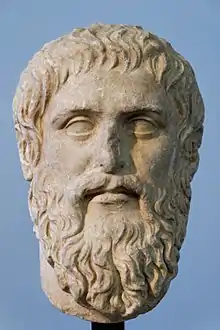



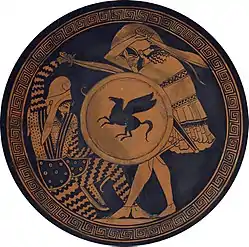
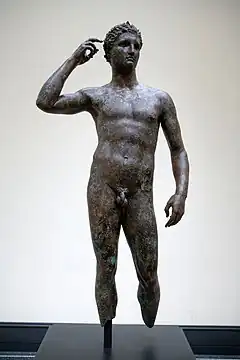


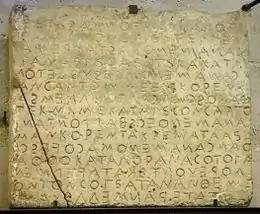
.JPG.webp)
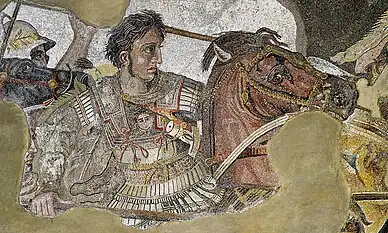
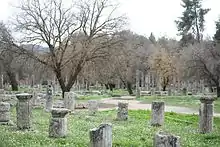
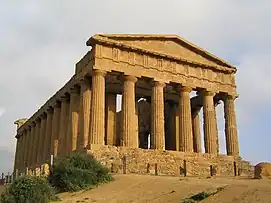
.jpg.webp)
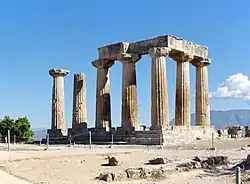
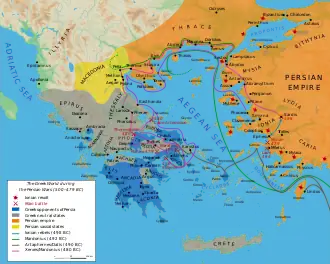
.jpg.webp)




